Elan 410 Standard
Sailboat specifications
The Elan 410 is a 40’4” (12.27m) cruiser-racer sailboat designed by Humphreys Yacht Design (United Kingdom). She was built between 2007 and 2012 by Elan Yachts (Slovenia).
The Elan 410 is as well listed, on Boat-Specs.com, in Deep draft version (see all the versions compared).
The Elan 410 is as well listed, on Boat-Specs.com, in Deep draft version (see all the versions compared).
Elan 410's main features
- Model
- Elan 410
- Version
- Standard
- Hull type
- Monohull
- Category
- Offshore cruiser-racer sailboat
- Sailboat builder
- Sailboat designer
- Country
- Slovenia
- Construction
- Hull and deck: GRP (glass reinforced polyester)
- First built hull
- 2007
- Last built hull
- 2012
- Appendages
- Keel : L-shaped keel (with bulb)
- Helm
- Single helm wheel
- Rudder
- Single spade rudder
- Unsinkable
- No
- Trailerable
- No
- EC design categoryiThe CE design category indicates the ability to cope with certain weather conditions (the sailboat is designed for these conditions)
A: Wind < force 9, Waves < 10m
B: Wind < force 8, Waves < 8m
C: Wind < force 6, Waves < 4m
D: Wind < force 4, Waves < 0,5m - A
- Standard public price ex. VAT (indicative only)
- N/A €
Elan 410's main dimensions
- Overall length
- 40’ 4”12.27 m
- Hull length
- 40’ 4”12.27 m
- Waterline length
- 37’11.28 m
- Beam (width)
- 12’ 10”3.91 m
- Draft
- 7’ 2”2.2 m
- Light displacement (MLC)
- 18982 lb8610 kg
- Ballast weight
- 6127 lb2779 kg
Elan 410's rig and sails
- Upwind sail area
- 988 ft²91.75 m²
- Downwind sail area
- 2216 ft²205.83 m²
- Mainsail area
- 543 ft²50.47 m²
- Genoa area
- 444 ft²41.28 m²
- Symmetric spinnaker area
- 1392 ft²129.35 m²
- Gennaker area
- 1672 ft²155.36 m²
- IiFore triangle height (from mast foot to fore stay top attachment)
- 54’ 8”16.66 m
- JiFore triangle base (from mast foot to bottom of forestay)
- 15’ 2”4.63 m
- PiMainsail hoist measurement (from tack to head)
- 53’16.16 m
- EiMainsail foot measurement (from tack to clew)
- 17’ 10”5.43 m
- Rigging type
- Sloop Marconi fractional
- Mast configuration
- Keel stepped mast
- Rotating spars
- No
- Number of levels of spreaders
- 2
- Spreaders angle
- Swept-back
- Spars construction
- Aluminum spars
Elan 410's performances
- Upwind sail area to displacementiThe ratio sail area to displacement is obtained by dividing the sail area by the boat's displaced volume to the power two-thirds.
The ratio sail area to displacement can be used to compare the relative sail plan of different sailboats no matter what their size.
Upwind: under 18 the ratio indicates a cruise oriented sailboat with limited performances especially in light wind, while over 25 it indicates a fast sailboat. - 235 ft²/T21.84 m²/T
- Downwind sail area to displacementiThe ratio sail area to displacement is obtained by dividing the sail area by the boat's displaced volume to the power two-thirds.
The ratio sail area to displacement can be used to compare the relative sail plan of different sailboats no matter what their size. - 527 ft²/T49 m²/T
- Displacement-length ratio (DLR)iThe Displacement Length Ratio (DLR) is a figure that points out the boat's weight compared to its waterline length. The DLR is obtained by dividing the boat's displacement in tons by the cube of one one-hundredth of the waterline length (in feet).
The DLR can be used to compare the relative mass of different sailboats no matter what their length:
a DLR less than 180 is indicative of a really light sailboat (race boat made for planning), while a DLR greater than 300 is indicative of a heavy cruising sailboat. - 170
- Ballast ratioiThe Ballast ratio is an indicator of stability; it is obtained by dividing the boat's displacement by the mass of the ballast. Since the stability depends also of the hull shapes and the position of the center of gravity, only the boats with similar ballast arrangements and hull shapes should be compared.
The higher the ballast ratio is, the greater is the stability. - 32 %
- Righting moment @ 30°iThe righting moment is a moment (torque) that tends to restore a boat to its previous position after heeling. Its value corresponds to the torque needed to heel the boat for this angle.
Higher the righting moment is for an angle, greater is the stability. - 28209 lb.ft3900 kg.m
- Maximum righting momentiThe righting moment is a moment (torque) that tends to restore a boat to its previous position after heeling. Its value corresponds to the torque needed to heel the boat for this angle.
Higher the righting moment is for an angle, greater is the stability. - 37250 lb.ft5150 kg.m @ 55.00 °
- Critical hull speediAs a ship moves in the water, it creates standing waves that oppose its movement. This effect increases dramatically the resistance when the boat reaches a speed-length ratio (speed-length ratio is the ratio between the speed in knots and the square root of the waterline length in feet) of about 1.2 (corresponding to a Froude Number of 0.35) . This very sharp rise in resistance, between speed-length ratio of 1.2 to 1.5, is insurmountable for heavy sailboats and so becomes an apparent barrier. This leads to the concept of "hull speed".
The hull speed is obtained by multiplying the square root of the waterline length (in feet) by 1.34. - 8.15 knots
Elan 410's auxiliary engine
- Engine(s)
- 1 inboard engine
- Engine(s) power
- 40 HP
- Fuel type
- Diesel
- Fuel tank capacity
- 38.3 gal145 liters
Elan 410's accommodations and layout
- Cockpit
- Closed aft cockpit
- Cabin(s)
- 3
- Berth(s) (min./max.)
- 6 / 8
- Head(s) (min./max.)
- 1 / 2
- Freshwater tank capacity
- 93.8 gal355 liters

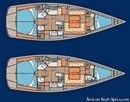

Elan Yachts Elan 410 layout - - 2/15
Picture extracted from the commercial documentation © Elan Yachts
Picture extracted from the commercial documentation © Elan Yachts


Elan Yachts Elan 410 sailing - - 3/15
Picture extracted from the commercial documentation © Elan Yachts
Picture extracted from the commercial documentation © Elan Yachts


Elan Yachts Elan 410 sailing - - 4/15
Picture extracted from the commercial documentation © Elan Yachts
Picture extracted from the commercial documentation © Elan Yachts


Elan Yachts Elan 410 sailing - - 5/15
Picture extracted from the commercial documentation © Elan Yachts
Picture extracted from the commercial documentation © Elan Yachts


Elan Yachts Elan 410 sailing - - 6/15
Picture extracted from the commercial documentation © Elan Yachts
Picture extracted from the commercial documentation © Elan Yachts


Elan Yachts Elan 410 sailing - - 7/15
Picture extracted from the commercial documentation © Elan Yachts
Picture extracted from the commercial documentation © Elan Yachts


Elan Yachts Elan 410 sailing - - 8/15
Picture extracted from the commercial documentation © Elan Yachts
Picture extracted from the commercial documentation © Elan Yachts


Elan Yachts Elan 410 sailing - - 9/15
Picture extracted from the commercial documentation © Elan Yachts
Picture extracted from the commercial documentation © Elan Yachts


Elan Yachts Elan 410 interior and accommodations - - 10/15
Picture extracted from the commercial documentation © Elan Yachts
Picture extracted from the commercial documentation © Elan Yachts


Elan Yachts Elan 410 interior and accommodations - - 11/15
Picture extracted from the commercial documentation © Elan Yachts
Picture extracted from the commercial documentation © Elan Yachts
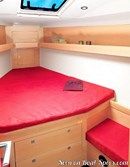

Elan Yachts Elan 410 interior and accommodations - - 12/15
Picture extracted from the commercial documentation © Elan Yachts
Picture extracted from the commercial documentation © Elan Yachts
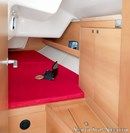

Elan Yachts Elan 410 interior and accommodations - - 13/15
Picture extracted from the commercial documentation © Elan Yachts
Picture extracted from the commercial documentation © Elan Yachts
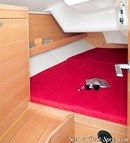

Elan Yachts Elan 410 interior and accommodations - - 14/15
Picture extracted from the commercial documentation © Elan Yachts
Picture extracted from the commercial documentation © Elan Yachts
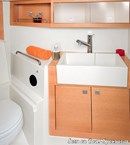

Elan Yachts Elan 410 interior and accommodations - - 15/15
Picture extracted from the commercial documentation © Elan Yachts
Picture extracted from the commercial documentation © Elan Yachts
Similar sailboats that may interest you:
Sailboats
First built hull
Hull length
2008
40’ 2”12.24 m
2006
42’ 6”12.95 m
2004
43’ 10”13.35 m
2004
44’ 6”13.55 m
2003
42’ 5”12.93 m
1998
42’ 7”12.98 m
2017
40’12.2 m
2014
37’11.28 m
2011
40’12.2 m
2008
43’ 1”13.15 m
1996
40’ 10”12.45 m
2008
37’ 2”11.34 m
2004
37’ 2”11.35 m
2006
36’ 6”11.12 m
2007
40’ 4”12.27 m